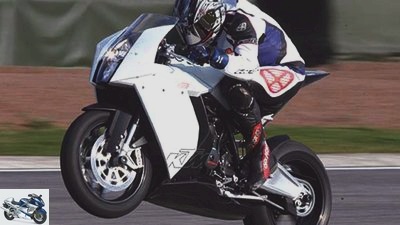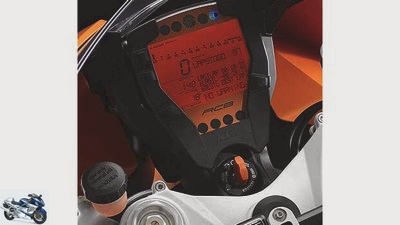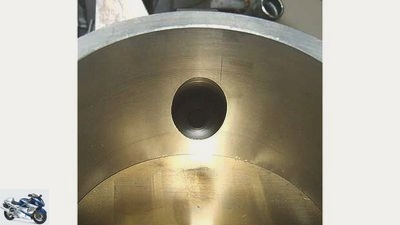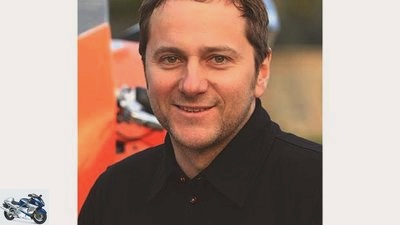Table of contents
- Technology: injection electronics What’s humming there??
- What’s humming there??
- The first 800 milliseconds
- Slow motion: from 1000 to 2000 milliseconds
- Martin Forster in an interview

K
counselor
technology & future
Technology: injection electronics
Technology: injection electronics
What’s humming there??
Content of
When five-year-olds imitate motorcycles, it sounds like “Bobbobb-Bobbobb”, “Brrrrummmm-brrrummmm” and “Miiiieouuuung”. But turn the ignition key on a modern bike and listen: That sounds more like a space insect. Or a computer as soon as it is switched on.
Manuel Fuchs
08/20/2008
What’s humming there??
The association with the PC is obvious: Many current motorcycles rely on electronics in the center of which – like the box under the desk at home – a CPU (“Central Processing Unit” = Central computing unit) sets the pace – but about fifty to one hundred times slower than on a standard computer. The CPU is the heart of the ECU (“Engine control unit” = Engine control unit), also known by its artist name “Black box”, which contains the operating system, software and data for all electronic processes on and in the motorcycle. Using the example of KTM 1190 RC8 PS once decoded in super slow motion what the black box and the components it supervised did in the first 2000 milliseconds after the ignition key was turned.
The first 800 milliseconds

K
Turning the ignition key basically gives the go-ahead.
0.000 Turn the ignition key
0.040 First of all, the ECU blocks the electric starter so that the motorcycle cannot be started before all components have reported their readiness for use to the ECU.
0.042 The electronics supply 9 sensors with 5 volts working voltage. A total of 14 sensors are in use on the motorcycle, 5 of which – for example the side stand and clutch sensors – do not need a separate power supply, but go directly to ground.
0.043 The fuel pump starts to work and pressurizes the fuel lines: 3.5 bar.
0.045 The ECU initializes 25 of its 34 outputs, which means that they receive a defined switching state. This step is important, otherwise a component could, for example, assume the state it was in when it was switched off – and there were probably completely different environmental conditions and requirements.
0.046 The stepper motor for the idle control starts the initialization of the primary throttle valves. Both primary throttle valves are opened and closed directly from the throttle using a Bowden cable, but an electronically operated cam regulates the throttle valve’s idle stop. In this way, the injection engine of the RC8 performs the function that the choke has on the carburettor engine. The initialization of the secondary throttle valves begins a little later. As a side note: The primary throttle valve is – perhaps a bit confusing – the one that the incoming air passes through second, i.e. closer to the inlet valves.
0.048 From now on, the following sensors report their readings to the ECU every thousandth of a second (i.e. at a frequency of 1000 Hertz): pressure sensors in the intake manifold, throttle valve potentiometer, crankshaft sensor and lean angle sensor (interrupts the power supply after a fall). The latter sits in the lamp mask and works like a pendulum – which does not interfere with driving because the centrifugal forces in the curves then keep the pendulum away from the critical area. Only when these centrifugal forces are absent and the motorcycle is still on a large lean angle does the engine stop. If you have an RC8 at hand, you can put it carefully on its side while the engine is running.
0.049 The following measured values are now sent to the ECU at 100 Hertz: temperature of the intake air, ambient pressure, oxygen content in the exhaust gas (important for optimal mixture formation and the best possible function of the catalytic converter), gear, clutch and side stand position (if the stand is in gear and the clutch is engaged is folded out, the ECU interrupts the ignition) and, last but not least, the battery voltage. The system has to know this because, among other things, it helps to determine the charging time of the ignition coils.
0.050 From now on, the ECU requests the coolant temperatures of the two cylinders from the dashboard at 10 Hertz via the central digital data line, the CAN bus. The temperatures of the two cylinders are measured individually and their cooling is controlled by their own thermostat, because the rear one usually runs warmer than the front one – a difference of 5 degrees Celsius is normal, in extreme racing it can be 10. Only because these values are digital, i.e. in the form of a 0/1 series, can they be transported over the CAN bus at all. Most of the other sensors on the KTM work analog and therefore transmit their values in the traditional way – digital sensors are currently still expensive and heavy. The weight savings that a digital data line brings in and of itself would then be quickly gone.
0.053 This is where the anti-theft device comes into play: Is there actually a registered key in the ignition lock? For 6 thousandths of a second, the ECU and immobilizer send values calculated from random numbers back and forth. The electronics only continue to work if the results are identical several times. If not, that is, when someone tries to short-circuit the motorcycle, it will only stir again after the ignition has been switched off and on again.
0.800 The ECU determines the starting injection duration from the coolant temperature, intake air temperature, ambient pressure, throttle valve opening and battery voltage. The injection nozzles only have two states: open and closed. For the transition from one to the other you need about 0.5 thousandths of a second with optimal battery voltage. The amount of fuel injected results – assuming constant pressure in the feed line – directly and linearly from the injection duration.
0.801 The stepper motor opens the throttle valve to the idle position.
Slow motion: from 1000 to 2000 milliseconds

K
The injection nozzles are located at an angle in the housing below the primary throttle valve (photographed from below).
1.502 If all the sensors give their okay – the motorcycle is upright, the gearbox is in neutral or the side stand is folded in, the registered key is inserted – the ECU enables the electric starter.
1,600 The driver presses the start button and the starter rotates the crankshaft.
1.601 The crankshaft sensor reports the rotation to the ECU. The ECU can recognize the position of the crankshaft based on the different tooth spacings on the sender sprocket (see page 49, graphic below on the right). Cycle detection begins.
1,650 The ECU receives a long tooth signal; From this moment the crankshaft position is known exactly.
1.655 The piston in the rear cylinder is at bottom dead center (BDC).
1.670 Both injection nozzles inject fuel into the two intake manifolds for 5 thousandths of a second, i.e. between the primary throttle valve and the intake valves. It helps to create a good mixture if the injection nozzles spray against it somewhere and not in a space that is as free of reflections as possible.
1.765 The piston in the rear cylinder is at top dead center (TDC). The crankshaft now rotates at around 300 rpm.
1,770 The front cylinder ignition coil is charging. Because the battery voltage is measured, the black box can calculate how long the coil needs to charge.
1,773 The ignition coil on the front cylinder is switched off so that it suddenly transfers its charge to the spark plug. This generates an ignition spark of around 750 ° C; the piston in the front cylinder is now about 8 degrees before TDC.
1,774 The spark ignites the injected mixture.
1,780 The piston in the front cylinder is at ignition TDC, the inlet and outlet valves of the front cylinder are closed.
1,786 Maximum combustion pressure in the front cylinder. In the first work cycle after starting, the temperature is around 550 ° C; with the engine at operating temperature up to 1300 ° C. By the time the flame front from the center of the cylinder reaches the cylinder wall, which is 51 millimeters away, it cools down to around 120 ° C. This is where the downside of short-stroke engines, as they are built to hunt for revs, lies: the combustion becomes more and more inhomogeneous and difficult to control, especially in the lower partial load range, for example in overrun mode; this worsens the response. To counteract this, the mixture is enriched by around 15 percent even without load – which manifests itself in higher consumption and in difficulties with homologation.
Another conclusion from this: Anyone who goes on the racetrack with their motorcycle, where exhaust gas limit values are irrelevant and the response behavior at low engine speeds is not a central problem, will find a lot of optimization potential in the coordination of the injection electronics.
1,787 From now on, the engine speed is recalculated for every encoder tooth that turns past the crankshaft sensor: If, for example, 24 teeth are evenly distributed over the circumference and 0.002 seconds pass between two tooth signals, this means that the crankshaft rotates 60 / (24 * 0.002) times, i.e. at 1250 rpm.
1,819 The exhaust camshaft of the front cylinder begins to open its exhaust valves
1,821 The cycle detection is complete, the on-board electronics now know exactly which cylinder is in which cycle. From the next cycle, each 720 ° crank angle will be injected in a cylinder-selective manner. (No longer in both cylinders at the same time, as in 1.670 seconds when the electronics only knew the crankshaft position.)
1,827 The injection duration is read from the mapping with the speed and the throttle position as input variables: The mapping (“map”) is in principle a fairly clear table in which an injection duration is assigned to around 20 speed values and just as many throttle angles. However, these 20 values are not evenly distributed: At low speeds and small throttle angles, they are close together because an engine is much more complex to tune in these areas. At higher speeds and when the throttle grip is more open, the intervals between the input values for which an injection duration is stored increase. If the current speed and / or the current throttle valve position are not exactly available in the table, the ECU interpolates the injection duration. This means that it calculates the required injection duration from the neighboring values in the table. The injection duration is corrected again based on the temperatures of the coolant and intake air, the intake manifold pressure and the battery voltage: the lower the battery voltage, for example, the longer it takes for the injectors to switch from closed to open (and vice versa).
1,830 The injection pulse at the front injection nozzle begins. Duration: 0.010 seconds.
1.853 The ignition coil of the rear cylinder provides the ignition spark.
1.857 The rear cylinder spark plug ignites the injected mixture.
1,860 Piston in the rear cylinder is at TDC.
1,866 Maximum combustion pressure in the rear cylinder.
1,870 Again, with the current speed and throttle position as input variables, an injection duration is read from the mapping, interpolated and corrected with the sensor data. The crankshaft has now completed its first two revolutions, rotates at around 1000 rpm and after two further revolutions will reach its idling speed of 1550 rpm (“bobbobb-bobbobb”). At operating temperature, each injector idles 775 times per minute for approximately 0.002 seconds. At full load (10,500 / min, gas tap at the stop, “Miiiieouuuuung”) each nozzle injects fuel 5250 times per minute for up to 0.0096 seconds. The consumption is then over 16 l / 100 km. In other words, the injection nozzles are open at full load for 50.4 seconds per minute, 84% of their working time. The mixture remains in the intake tract until the intake valves open.
Martin Forster in an interview

KTM
? How much of a role does electronics play in getting power out of an engine??
! The top performance makes comparatively little work when coordinating the mapping; what is possible there determines much more the structural design of the engine. It takes us much longer to achieve a smooth response and proper development at low and medium speeds, especially at low loads – the more an engine is trimmed for high speeds and peak performance, the more difficult it is. Half a year can go into the country for this.
? Are motorcycles becoming more and more electronic, or will there be a limit at some point??
! A limit has certainly been reached when larger mechanical components are to be moved electrically. For valves that are operated via relays – the idea already existed, of course – you would need an incredibly powerful alternator, for example. And I don’t think that perfectly functioning traction control on motorcycles will go into production in the near future. This requires a large number of measured values that cannot be measured sensibly with a reasonable financial outlay. What is currently on the market should “Traction help” hot because it only works when driving straight ahead; and the system of the Ducati 1098R has to be adjusted by the driver every time.
? There are things that annoy you about your job?
! As long as it comes down to having ideas and testing them, nothing is annoying at all. Even if we drive around in the rain for a whole day to optimize a mapping and in the end do not have a reasonable result, I basically like to do that. Only when the paperwork gets out of hand do my colleagues hear me cursing. Oh yes, I also annoy that electronics are often to blame for everything – a computer knows no manufacturing tolerances: 3 milliseconds are always 3 milliseconds, never 2.998 and never 3.002. If, for example, an engine jerks while coasting, that is much more of a design problem and one of the emissions laws – we electronics technicians can do very little about it.
? What about legal exhaust and noise regulations??
! If it didn’t exist, my job would be easier and the tuners would have almost nothing to do. On the other hand, we technicians have to face reality and accept the challenge.
? For a two-stroke fan, could you reprogram the injection of the RC8 so that it feels as sharp as a two-stroke racer?
! I don’t know why you would want that, but that wouldn’t be particularly difficult.
? Now if a PS reader thinks: “I would also like to do a job like the Forster” – what do you advise him?
! The most important thing is that he is passionate about motorcycles and has a thorough understanding of what happens in an engine, how everything is interrelated. Riding a motorcycle yourself is an absolute must; much more important, for example, than being able to program. Voting takes up the bulk of the work; Feeding numbers to electronics isn’t that complicated.
Related articles
-
Technology: BMW S 1000 RR engine in detail
BMW 13th pictures Artist 1/13 The on-board tool kit of the BMW almost ties in with old traditions. With the help of the nine-part set you can strip the…
-
Yamaha 20th pictures KTM 1/20 HP knowledge technology part 17 – Electronic injection and engine control. Yamaha 2/20 HP knowledge technology part 17 -…
-
Guide: Injection on a motorcycle
Drawing: Schermer counselor technology & future Guide: Injection on a motorcycle Guide: Injection on a motorcycle Find and rectify faults in the…
-
MV Agusta F3 engine: the technology
manufacturer counselor technology & future MV Agusta F3 engine: the technology Technology: MV Agusta F3 engine The engine of the super sports car from MV…
-
MotoGP technology: valve trains
counselor workshop MotoGP technology: valve trains MotoGP technology: valve trains Sex offender Stoner? Traction control? Tire technology? Happiness? It…
-
motorcycles Enduro Technology Honda CRF 450 R Technology Honda CRF 450 R For the sake of simplicity Why complicated when it can be made easy? This is…
-
This is how the new super sports technology works
Suzuki 20th pictures Suzuki 1/20 The Suzuki GSX-R combines high tech with clever engineering. Suzuki 2/20 This centrifugal force mimic adjusts the timing…
-
Flashing electronics tuning chip control unit
Bilski accesories Flashing electronics tuning chip control unit Electronics tuning, chip, control unit Flash, flash, flash! Content of Overwriting…
-
Technology of the 2002 model year
motorcycles Technology of the 2002 model year Technology of the 2002 model year Undercover In the 2002 season it is the inner values that count, and…
-
Technology of the new 600 super sports car
counselor technology & future Technology of the new 600 super sports car Technology of the new 600 super sports car New base The new 600 super athletes…